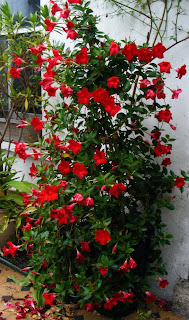The invasion begins. It has been a great year so far with lots of rain and heat, so the garden is monstrous. I finally finished weeding the entire garden two days ago--lots of feed for the sheep. It took me 3 days, and each day I hauled away 3 or 4 tractor buckets of weeds.
Cucumbers from the patch. Notice the dill in between and the Lemon Gem tagetes marigolds, which keep aphids away from the dill. Also note the snapdragons--flowers help with pollination:
Bright Lights Swiss chard--almost 2 feet tall.
Squashes--mini orange and green hubbards,
Watermelon
Spaghetti squash
View of garden over the potatoes, tomatoes in center corn in the back.
Sparky next to evening scented stocks, next to celery, in front of zucchini, lavatera and corn.
Tomatoes--we picked all the red ones yesterday:
Tomatilloes--green on left, purple on right.
Zucchini--gave a big one to the neighbor yesterday--hers didn't grow.
Stocks to waft the evening air with heavenly scent, and to help pollinate in the daytime.
Beans front left, flower bed right: I love cosmos, and calendula and zinnias (which the sheep nipped off but are re-growing. I am trying Vinca this year--the short row in front of the calendula.
Lettuces and beans
Onions
Purple and green kale
Sweet and hot banana peppers
The fig tree--started out as a little 15" stick this spring. We will bring him in for the winter. He/she has lots of fruit, I hope they will develop. A fig is a uterus. This variety is self-pollenating--the flower is inside the shell. Commercial figs are pollinated by one certain wasp which crawls inside a small hole in the end to pollenate.
And now for some
Eye Candy: Pretty flowers on the deck:
Mandevillas-- these didn't sell in the Greenhouse because they didn't bloom in time. I plan on trying to winter them over and start them early in the greenhouse season so they can sell next year.
Calliope Geraniums: from Proven Winners--an interspecific geranium--cross between zonal and ivy . This flower is the most beautiful shade of red I have ever seen--it's captivating. My poor photography likely won't do it justice.
Seed Geranium--Bullseye salmon. The special thing about this one is the color of the leaves. Chocolate brown with green rims.
Martha Washington Geraniums (aka Regals, aka Pansy Geraniums)
Mixed pot of zonal geraniums, scaevola, verbena lotus and Beaconsfield pansies
I hope you enjoyed the tour.
I just realized it's only 5-6 weeks since I finished planting the garden. What a miracle. The garden is 55 feet by 85 feet, and will soon be covered with all sorts of plants and vines. I hope not too many weeds.













































.jpg)



.jpg)





